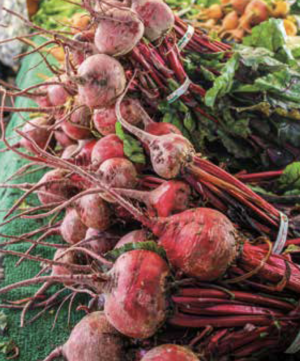
Cooking as a Radical Act: Food as Medicine
Eating nutritious, real food is the most significant step toward a long, robust life. And don’t forget that bone health is part of total nutrition. Take your food as medicine and medicine for your bones.
And you don’t have to sacrifice taste for bone health or a plant-based diet! Read on for anyone who makes plant foods a major part—or a full part—of their daily diet.
Below is an excerpt from Robust Bones Plant-Based Nutrition Plan and Cookbook By Laura KellyHelen Kelly and Jummee Park. It has been adapted for the web.
The natural world, in flow, contains everything your body needs to achieve long life in good health, starting at any age and in almost any state of health. And food is the first, most significant and most effective tool of medicine.
But why bone health? Why health?
Of course, we want to feel good, to live without pain. But there is more. When we are ill, we have to focus on ourselves. But when we are robust, we are able to reach out, to others, to the world, to embrace and connect.
Our spirit is free to roam and we can open ourselves to magic. There is much to learn to achieve this type of bliss through connecting with nature and food.
Once you know the preparation methods
To counteract anti-nutritional factors, you’ll love combining fresh vegetables and other plant foods in salads, soups, and main dishes like these
Let’s start with the basics.
Eat a wide variety of plants. Find sources of plant foods grown in soil and water that are robust and free from toxic chemicals. Eat seasonal plants and prepare them to be most nutritious and delicious. Employ these plant foods, under the guidance of a physician, as part of managing chronic or intermittent health issues. Know your health status and challenges and eat preventatively.
There is a wealth of information out there that can influence your food and cooking choices, and we encourage you to explore and identify your body’s preferences and needs. Fortunately, our bodies often know what we need, and if we listen, we intuitively reach for foods that will satisfy the need.
Once you understand your constitution (through self-monitoring or working with a professional dietitian or doctor), the season, and the nature of food, you can open yourself to another level of eating in harmony with your body, food, and nature itself. This is where cooking becomes true alchemy.
That’s why Laura advises all her patients: listen to your body.
Second, appreciate the value of the food in your fridge or pantry, not just as food but also as the energy and effort it took to grow it. Think of the sprouts you’re about to eat as having grown from nuts, beans, lentils, or seeds that were nourished, watered, protected, and harvested, probably by hand. Then they were dried and cleaned, packaged and shipped, stored, and sold, all by people you may never meet but who care about the plants that will lend a hand your body stay robust.
Third, recognize that your feelings affect those around you and affect what you create. Infuse what you cook to nourish yourself and those you care about with what you want to convey. Your food can communicate love, generosity, and compassion. If you doubt these subtle arts, remember that we do not yet understand the physics that underlies our universe and err on the side of love.
Cooking is a radical activity.
In the face of Massive Agriculture, Massive Chemistry, and Massive Pharma, the decision to engage with food—spending money on neat, well-grown, real food, bonding with fellow cooks, feeding yourself and your loved ones well to stay robust—becomes a revolutionary act.
Diminutive steps to start with
Below are some suggestions for specific food combinations that can lend a hand overcome some of the problems caused by antinutritional factors.
Spinach and tomatoes. Try fresh wilted spinach with olive oil, garlic, and sautéed tomatoes. To make wilted spinach, wash it three times and soak it for twenty minutes—soaking will begin to discolor the very mighty oxalate bond with the spinach’s impressive calcium stores—then sauté it in water or olive oil. Although tomato skins and seeds feed the body with lycopene, they also contain lectins. If lectins affect digestion, peel and seed the tomatoes before sautéing them. Sautéing reduces the solanine content. Also try our Silky Tofu–Spinach Dip (page 141) or Sweet Potato Boats with Creamy Spinach (page 238).

Beetroot is a major source of nitric oxide, but it’s also a stronghold of the antinutritional oxalate. Always add a little citric acid to your beets—maybe a squeeze of fresh lemon—which will dilute the oxalates.
Beetroot. Combine beets, watercress, and pistachios with olive oil and a lemon-juice vinaigrette. The lemon juice reduces the beets’ vast portion of oxalates to a whine. Watercress, like kale, is a low-oxalate green. Pistachios are among the edible seeds with the lowest phytate content (called nuts for convenience, they are neither legumes nor nuts, but the nutrient-dense seeds of the pistachio tree).
Sweet potatoes. Cook sweet potatoes to minimize both oxalates and acrylamide. Eat the potato skin and all.
Apples and pears. To reduce tannin content, boil these fruits instead of roasting or baking them.
Nuts. Almonds, walnuts, and Brazil nuts are among the most nutrient-dense nuts, but they also have the most phytic acid. Choose sprouted almonds and, if possible, remove the skins. You can also sprout your own using the same method as for sprouting beans.
Soak walnuts and Brazil nuts in water with a pinch of salt for at least twelve hours, preferably not in the refrigerator. Drain well. Then dehydrate the nuts in a food dehydrator, if you have one. If you don’t have one, spread the well-drained nuts in a single layer on a baking sheet and arid them in the oven at 115°F (45°C) for 12 hours.
While soaking is the first step in sprouting lentils or beans, sprouting nuts is more complicated. Almonds sprout easily and have a root. Walnuts, pistachios, and Brazil nuts won’t have a stalk when soaked and dehydrated, but soaking and dehydrating can still weaken their antinutritional properties. Hazelnuts require prolonged exposure to frigid temperatures to stimulate germination, but they are low in phytate, so most people can eat hazelnuts without any preprocessing. Cashews aren’t true nuts; botanically, cashews are drupes, seeds in a fleshy fruit. Commercial cashews are preprocessed to remove the urushiol toxin, so they’re no longer viable and won’t sprout.
Pak choi with mushrooms. Try pak choi, cilantro, onion, garlic, and a handful of mushrooms. Paki choi is one of the lowest-oxalate vegetables, and its enviable content of an antioxidant called quercetin makes it one of the best anti-inflammatory vegetables. Cilantro and coriander chelate bulky metals, mushrooms improve metabolic health, onion is prebiotic (your good gut bacteria will thank you), and garlic regulates blood pressure. If you’re pescatarian, add shrimp. Season with dill for calcium; red pepper flakes are optional.
Chocolate. Nature is an eternal contradiction, and nothing demonstrates this dual nature better than chocolate. Cacao beans are fermented, which helps break down tannins, and roasted to develop the cocoa flavor used to make chocolate. The roasting process can create high levels of acrylamide. Although murky chocolate offers a legion of health benefits, it contains more acrylamide than products with lower cocoa content. What about cacao beans? Those sold as raw are usually fermented but not roasted, and there is mighty evidence that raw cacao beans offer antioxidant and anti-inflammatory benefits that are associated with 70 percent or higher murky chocolate, as well as some suggestion that they lend a hand reduce insulin resistance.8 We also note that most commercial chocolate contains some level of bulky metals.
Green tea. A component of green tea, catechin, appears to sluggish the growth of osteoclast precursor cells in the bone marrow, which helps restore the balance in favor of osteoblasts in the case of osteoporosis. However, green tea also contains tannins, which can inhibit the absorption of iron and zinc. The solution is plain: Drink the tea half an hour before or after a meal.
Dried fruit. Make prunes opulent in boron your choice. For most people, prunes seem to be a bone-protective food, although prunes produce a compact amount of acrylamide during the drying process. Two to six prunes a day seem to protect bone density. Avoid prune juice, however, because it contains a strikingly high amount of acrylamide. You can also eat a compact handful of dried mulberries from time to time.
Mulberries are a good source of calcium, vitamin K, and non-heme iron, but eating more than an occasional handful may interfere with mineral absorption.
